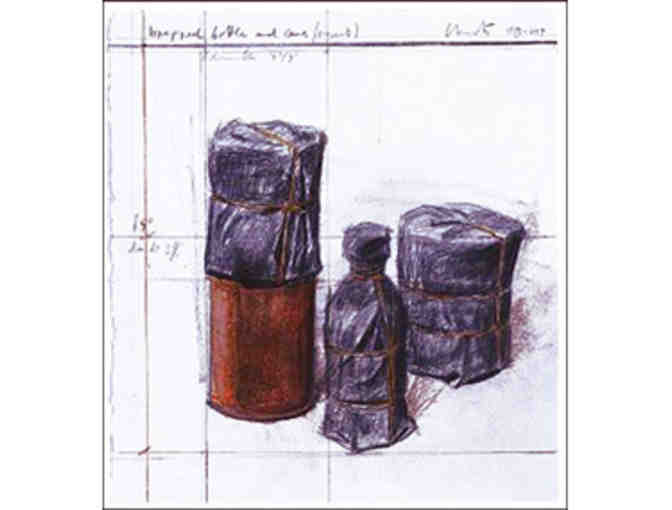Christo: Wrapped Bottle and Cans (project)

Item Number: 201
Time Left: CLOSED
Description
Christo "Wrapped Bottle and Cans (project)", 1958-2004
Lithograph
Paper & image size, 15 1/4 x 13 3/4 in.
AP 9/50 (edition of 200)
Christo and Jeanne-Claude, respectively, in full Christo Javacheff and Jeanne-Claude de Guillebon (respectively, born June 13, 1935, Gabrovo, Bulg. born June 13, 1935, Casablanca, Mor.—died Nov. 18, 2009, New York City, N.Y., U.S.), environmental sculptors, noted for their controversial outdoor sculptures and monumental displays of fabrics and plastics.
Christo attended the Fine Arts Academy in Sofia, Bulg., and had begun working with the Burian Theatre in Prague when the Hungarian Revolution of 1956 broke out. He fled to Vienna, where he studied for a semester, and then, after a brief stay in Switzerland, moved to Paris and began exhibiting his works with the nouveaux réalistes. While working there as a portrait artist, Christo met Jeanne-Claude de Guillebon, whom he married in 1959. Jeanne-Claude was once described as her husband’s publicist and business manager, but she later received equal billing with him in all creative and administrative aspects of their work. In 1964 the pair relocated to New York City, where their art was seen as a form of Arte Povera.
Christo’s earliest sculptures were composed of cans and bottles—some as found and some painted or wrapped in paper, plastic, or fabric. Christo and Jeanne-Claude’s first collaborative works included Dockside Packages (1961; Cologne), Iron Curtain—Wall of Oil Drums (1962; Paris), and Corridor Store Front (1968; New York City). In 1968 they also completed a suspended 18,375-foot (5,600-metre) “air package” over Minneapolis, Minn., and “wrapped buildings” in Bern, Switz.; Chicago, Ill.; and Spoleto, Italy. Their monumental later projects included Valley Curtain (1972; Rifle Gap, Colo.), Running Fence (1976; Marin and Sonoma counties, Calif.), and Surrounded Islands (1983; Biscayne Bay, Fla.). In 1985 in Paris, they wrapped the Pont Neuf (bridge) in beige cloth. In a 1991 project, the couple installed 1,340 giant blue umbrellas across the Sato River valley in Japan and 1,760 giant yellow ones in Tejon Pass, California. Four years later they wrapped the Reichstag in Berlin in metallic silver fabric. The Gates, Central Park, New York City, 1979–2005 was unveiled in 2005. Stretching across 23 miles (37 km) of walkway in Central Park, the work featured 7,503 steel gates that were 16 feet (5 metres) high and decorated with saffron-coloured cloth panels. The Gates was on display for 16 days and attracted more than four million visitors.
Christo and Jeanne-Claude’s huge, usually outdoor sculptures are temporary and involve hundreds of assistants in their construction. Seen as they are by all manner of passersby, including those who would not necessarily visit museums, these works force observers to confront questions regarding the nature of art. As the scope of the projects widened, increased time was needed for planning and construction phases, the securing of permits, and environmental- impact research. For each project, they formed a corporation, which secured financing and sold the primary models and sketches. Most installations were documented in print and on film, and the materials that created them were sold or given away after the projects were dismantled.
Special Instructions
THE TOTAL AMOUNT OF THE SALE IS THE FINAL PRICE OF THE ITEM. SHIPPING CHARGES ARE NOT INCLUDED AND WILL BE PAID BY THE BUYER.